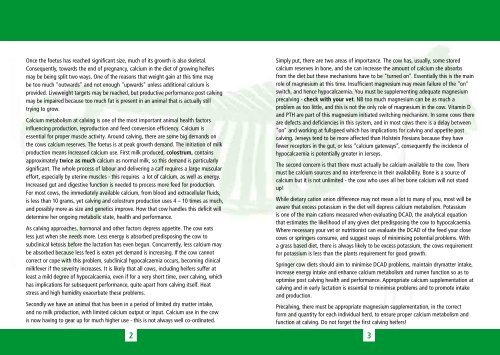CALCIUM & THE DAIRY COW - McDonald's Lime
CALCIUM & THE DAIRY COW - McDonald's Lime
CALCIUM & THE DAIRY COW - McDonald's Lime
You also want an ePaper? Increase the reach of your titles
YUMPU automatically turns print PDFs into web optimized ePapers that Google loves.
Once the foetus has reached significant size, much of its growth is also skeletal.<br />
Consequently, towards the end of pregnancy, calcium in the diet of growing heifers<br />
may be being split two ways. One of the reasons that weight gain at this time may<br />
be too much "outwards" and not enough "upwards" unless additional calcium is<br />
provided. Liveweight targets may be reached, but productive performance post calving<br />
may be impaired because too much fat is present in an animal that is actually still<br />
trying to grow.<br />
Calcium metabolism at calving is one of the most important animal health factors<br />
influencing production, reproduction and feed conversion efficiency. Calcium is<br />
essential for proper muscle activity. Around calving, there are some big demands on<br />
the cows calcium reserves. The foetus is at peak growth demand. The initiation of milk<br />
production means increased calcium use. First milk produced, colostrum, contains<br />
approximately twice as much calcium as normal milk, so this demand is particularly<br />
significant. The whole process of labour and delivering a calf requires a large muscular<br />
effort, especially by uterine muscles - this requires a lot of calcium, as well as energy.<br />
Increased gut and digestive function is needed to process more feed for production.<br />
For most cows, the immediately available calcium, from blood and extracellular fluids,<br />
is less than 10 grams, yet calving and colostrum production uses 4 – 10 times as much,<br />
and possibly more as size and genetics improve. How that cow handles this deficit will<br />
determine her ongoing metabolic state, health and performance.<br />
As calving approaches, hormonal and other factors depress appetite. The cow eats<br />
less just when she needs more. Less energy is absorbed predisposing the cow to<br />
subclinical ketosis before the lactation has even begun. Concurrently, less calcium may<br />
be absorbed because less feed is eaten yet demand is increasing. If the cow cannot<br />
correct or cope with this problem, subclinical hypocalcaemia occurs, becoming clinical<br />
milkfever if the severity increases. It is likely that all cows, including heifers suffer at<br />
least a mild degree of hypocalcaemia, even if for a very short time, over calving, which<br />
has implications for subsequent performance, quite apart from calving itself. Heat<br />
stress and high humidity exacerbate these problems.<br />
Secondly we have an animal that has been in a period of limited dry matter intake,<br />
and no milk production, with limited calcium output or input. Calcium use in the cow<br />
is now having to gear up for much higher use - this is not always well co-ordinated.<br />
2<br />
Simply put, there are two areas of importance. The cow has, usually, some stored<br />
calcium reserves in bone, and she can increase the amount of calcium she absorbs<br />
from the diet but these mechanisms have to be "turned on". Essentially this is the main<br />
role of magnesium at this time. Insufficient magnesium may mean failure of the "on"<br />
switch, and hence hypocalcaemia. You must be supplementing adequate magnesium<br />
precalving - check with your vet. NB too much magnesium can be as much a<br />
problem as too little, and this is not the only role of magnesium in the cow. Vitamin D<br />
and PTH are part of this magnesium initiated switching mechanism. In some cows there<br />
are defects and deficiencies in this system, and in most cows there is a delay between<br />
"on" and working at fullspeed which has implications for calving and appetite post<br />
calving. Jerseys tend to be more affected than Holstein Fresians because they have<br />
fewer receptors in the gut, or less “calcium gateways”, consequently the incidence of<br />
hypocalcaemia is potentially greater in Jerseys.<br />
The second concern is that there must actually be calcium available to the cow. There<br />
must be calcium sources and no interference in their availability. Bone is a source of<br />
calcium but it is not unlimited - the cow who uses all her bone calcium will not stand<br />
up!<br />
While dietary cation anion difference may not mean a lot to many of you, most will be<br />
aware that excess potassium in the diet will depress calcium metabolism. Potassium<br />
is one of the main cations measured when evaluating DCAD, the analytical equation<br />
that estimates the likelihood of any given diet predisposing the cow to hypocalcaemia.<br />
Where necessary your vet or nutritionist can evaluate the DCAD of the feed your close<br />
cows or springers consume, and suggest ways of minimising potential problems. With<br />
a grass based diet, there is always likely to be excess potassium, the cows requirement<br />
for potassium is less than the plants requirement for good growth.<br />
Springer cow diets should aim to minimise DCAD problems, maintain drymatter intake,<br />
increase energy intake and enhance calcium metabolism and rumen function so as to<br />
optimise post calving health and performance. Appropriate calcium supplementation at<br />
calving and in early lactation is essential to minimise problems and to promote intake<br />
and production.<br />
Precalving, there must be appropriate magnesium supplementation, in the correct<br />
form and quantity for each individual herd, to ensure proper calcium metabolism and<br />
function at calving. Do not forget the first calving heifers!<br />
3


